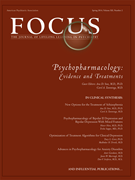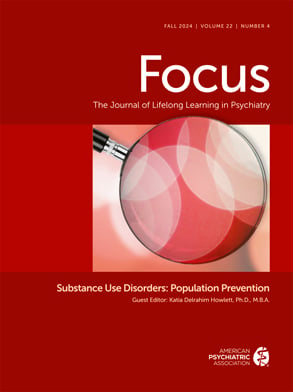Self-Assessment
Go to apaeducation.org to complete the self-assessment.
1. Which of the following atypical antipsychotics has moderate strength evidence of efficacy for off-label use as a monotherapy (single-agent) treatment for major depressive disorder (MDD)?
2. What is the conclusion of the AHRQ report about the efficacy of antipsychotic medications as augmenting agents of antidepressants for MDD?
a.
All atypical antipsychotics have a strong level of evidence of efficacy as augmentation agents.
b.
Evidence showed atypical antipsychotics were no better than placebo.
c.
Aripiprazole, quetiapine, and risperidone have efficacy with moderate or high evidence.
d.
Head to head trials have shown which agent is most efficacious.
e.
Ziprasidone and olanzapine have moderate or high evidence of efficacy.
3. When using an atypical antipsychotic agent to augment an antidepressant medication in nonpsychotic unipolar depression, which of the following measures is most likely to be useful for managing side effect(s)?
b.
Monitoring serum potassium (K+).
c.
Monitoring urinary 3-Methoxy-4-hydroxyphenylglycol (MHPG).
d.
Monitoring finger-to-nose coordination.
4. For treatment of patients with PTSD without psychosis, what does the most recent evidence reflected in the Department of Defense (DoD) guideline currently recommend regarding the use of atypical antipsychotics in the treatment of these patients?
a.
Recommended as monotherapy.
b.
Recommended as augmentation.
5. A 28-year-old female veteran is receiving cognitive-processing therapy for intrusive memories of dead bodies she saw while serving in Afghanistan. When she has these memories, she feels as if she is there, and feels extremely distressed. In addition, she finds herself avoiding public places, and startling easily when approached by her family. She describes herself as “angry” all the time; however, she does feel her sleep, appetite, and energy are normal. After several months of therapy she is less irritable but continues to have the intrusive visions. Which of the following medications has the best evidence for efficacy in treating her symptoms?
6. According to the 2011 AHRQ review, which atypical has the highest level of confidence for effectiveness to support its use in the management of dementia-related agitation?
7. A psychiatry consultation is requested for a 72-year-old nursing home resident with major neurocognitive disorder because of Alzheimer’s disease. In the past, the patient had been violent, injuring both himself and others. Behavioral interventions were tried without success. One year prior, the patient was put on risperidone (1 mg) and showed improvement. An attempt to lower his dose 6 months later resulted in worsening behaviors, and the patient was returned to 1 mg. Since then, there have been no incidents. He also receives hydrochlorothiazide and atenolol for hypertension. His gait is somewhat slow but the nurses insist that this was the case before he was started on risperidone.
A recent pharmacy review questioned the use of antipsychotics for a nonpsychotic patient and informed the Director of Nursing that these drugs are associated with increased mortality in patients with dementia. As a result, the Director of Nursing is requesting an alternative drug. The patient’s family, however, expresses concern over the possibility that the patient’s agitation may return. Which of the following would be the most appropriate recommendation for a psychiatric consultant to give?
a.
Continue the risperidone, titrating to lowest effective dose.
b.
Continue the risperidone but add adjunctive benztropine.
c.
Discontinue risperidone and use behavioral interventions instead.
d.
Discontinue risperidone and administer fluoxetine.
e.
Switch from risperidone to aripiprazole.
8. Which of the following atypical antipsychotics is most likely to cause weight gain in elderly patients?
9. In nonelderly adults (18–64) taking atypical antipsychotic medications, what does the evidence show about antipsychotics and weight gain in this patient group?
a.
All antipsychotics are associated with equal weight gain.
b.
Weight gain is not associated with off label use.
c.
Olanzapine is associated with the most weight gain.
d.
Quetiapine is associated with the most weight gain.
e.
Risperidone is associated with the most weight gain.
10. A 46-year-old woman sees a psychiatrist for ”chronic anxiety.” She has always been an anxious person but has noticed more symptoms in the past 6 months when she returned to the workforce after being home with her children for 10 years. She has difficulty concentrating, and feels on edge at work. She also has difficulty falling asleep and feels fatigued during the day. She says she is not depressed, just “worried all the time.”
She denies any substance use or medical problems. Her physical last year was unremarkable. Which of the following medications would be a first choice to help this patient?
11. In the 2011 AHRQ review, which of the following studied atypical medications has the most evidence for effective treatment of moderate generalized anxiety disorder?
12. What is the best estimate of risk of tardive dyskinesia with atypical antipsychotics compared with typical antipsychotics?
b.
The same risk as typical antipsychotics.
c.
10% of the risk of typical antipsychotics.
d.
Risk estimates vary between 25% and 55% of the risk of typical antipsychotics
13. A 20-year-old college student is referred to a psychiatrist by the student health service for possible eating disorder. She has lost 30 pounds and now weighs 95 pounds at 5′4”. She says she feels fat and would like to lose more weight. She does not binge or purge, although in high school she once tried using laxatives to lose weight. Her electrolytes and lab tests are all WNL.
What is the next step the psychiatrist should take?
a.
Arrange a family meeting.
b.
Observe her eating a meal.
e.
Begin psychosocial interventions.
14. For the treatment of patients with eating disorders, what does the evidence show regarding the use of atypical antipsychotics to increase body mass index (BMI) in patients with anorexia nervosa (AN)?
a.
Evidence for BMI increase with olanzapine in AN patients.
b.
Evidence for BMI increase with risperidone in AN patients.
c.
Evidence for BMI increase with all atypical antipsychotics in AN patients.
d.
Evidence is inconclusive for increase in BMI in AN patients.
e.
Evidence for BMI increase with quetiapine in AN patients
15. What do the data show about efficacy of atypical antipsychotics in the treatment of substance use disorders?
a.
There is low strength evidence of efficacy.
b.
There is moderate strength evidence of efficacy.
c.
There is strong evidence of efficacy.
d.
There have been no studies.
e.
There is evidence of low to moderate strength for inefficacy.
16. A 35-year-old stockbroker is referred to you for treatment of methamphetamine addiction. Which of the following is the most effective treatment for this addiction?
b.
Exposure and response prevention.
d.
Cognitive behavior therapy.
17. A 45-year-old woman complains that she has difficulty falling asleep almost every night. This is a long standing problem but has worsened over the past several months as her job has become more stressful. She watches TV in bed and has been drinking a glass of wine before bed, which seemed to help, but she then began waking up at 2 a.m. and is not able to get back to sleep. What would be the best treatment at this time?
b.
CBT and sleep hygiene education.
18. Treatment of adolescents and children with atypical antipsychotic medications, including olanzapine, risperidone, quetiapine, and aripiprazole, for psychotic and bipolar disorders was associated with:
a.
An increased risk for obesity.
b.
An increased risk for metabolic adverse events (cardiovascular, cerebrovascular, or hypertensive adverse event).
c.
No increased risk for obesity.
d.
No increased risk for metabolic abnormalities.
19. The AHRQ report reviewed the evidence for atypical antipsychotics in the treatment of Borderline Personality Disorder (BPD). What does the evidence show regarding treatment of Borderline patients with atypical antipsychotics? For which symptoms of BPD do atypical antipsychotics have the best evidence?
b.
Core disturbances in manifestations of self.
c.
Impulsivity and aggression.
d.
Interpersonal dysfunction.
20. Which of the following medications would be the first choice for a 10-year-old boy with ADHD and no serious co-occurring disorders?
21. The AHRQ review reported on the effectiveness of atypical antipsychotics as medication augmentation in obsessive compulsive disorder (OCD) as studied in two different experimental designs: one in which specific atypical antipsychotics augment any SRI antidepressant and the other in which they augment citalopram. Some atypical antipsychotics have shown efficacy. When augmenting SRIs, which atypical has the most evidence for effectiveness?
22. According to the 2011 AHRQ review, for elders (≥65 years old) receiving atypical antipsychotic agents for the management of dementia, stroke (CVA) was significantly higher in medication than placebo subjects for which medication?
24. In adults treated with atypical antipsychotics, which of the following atypical antipsychotics has shown the lowest risk of extrapyramidal symptoms?
25. Which of the following is an approved indication for treatment with an atypical for a use other than for psychosis?
a.
Behavioral symptoms of dementia.
b.
Monotherapy for major depressive disorder.
c.
Augmentation of selective serotonin reuptake inhibitors (SSRIs) in OCD.
d.
Augmentation of SSRIs in major depressive disorder.

